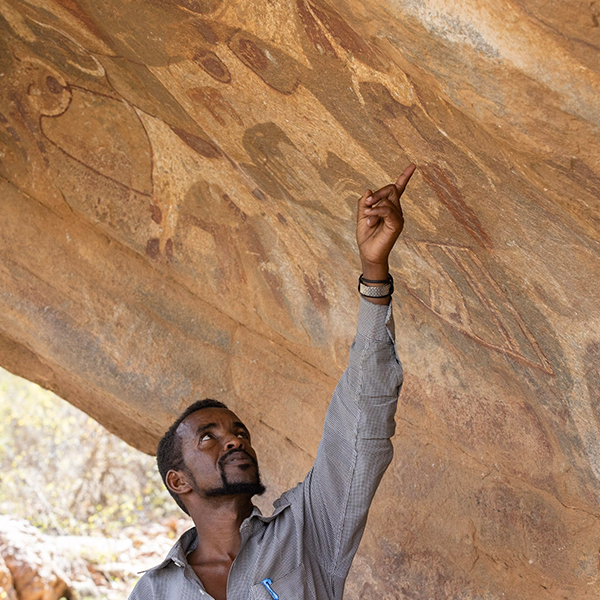Back in 1988, the Society of Friends of the Royal Tombs of Egypt had proposed that a facsimile would be the best approach to ensure the preservation and accessibility of the tomb. For the 2001 recording project, Factum recorded 16 square meters of the tomb's surface at a resolution of 100 microns, a level of precision that is still seldom matched by digital recording experts today: the 3D recording in the tomb of Seti I is 2500 times higher than the recording used to create the Altamira facsimile.

Rematerialising data: two 3D prints of data recorded in 2001 (left) and 2016 (right) overlaid on the facsimile section of the Hall of Beauties © Adam Lowe
In 2016, when the Tomb of Seti I was reopened to the public after almost 30 years of closure, the Theban Necropolis Preservation Initiative (TNPI) embarked on a comprehensive digital recording of the tomb's walls and structure in collaboration with the Egyptian Ministry of Antiquities. The Ministry acknowledged the potential of high-resolution digital recording for preservation, dissemination, and exhibitions, while the TNPI also focused on training and empowering local communities to create a self-sufficient digital recording capability.
The first local Egyptian operators were trained and led by Aliaa Ismail and Factum Foundation operators, establishing a workflow of operations and the use of non-contact technologies, thereby creating the first fully Egyptian digital recording team. By 2017, the 3D Scanning, Archiving, and Training Centre was relocated inside the restored Stoppelaëre House in Luxor, where most recording operations and data processing took place. The Factum Foundation's headquarters in Madrid provided funding and occasional support.
Maintaining constant collaboration with the Ministry of Antiquities ensured that the work adhered to regulations. The Ministry also received a copy of the recorded data and agreed to make it publicly accessible as a resource for educational and academic purposes through the provided viewers.
The recording process and technologies
The recording process and technologies involved a combination of scanning techniques suitable for various aspects of documenting the tomb. Portable and highly customisable technologies were used to overcome the challenges posed by the narrow and dimly lit environment.
LiDAR scanning was used to create an initial 3D model of the entire Tomb of Seti, employing a FARO Focus 3D x 130 Scanner to obtain precise measurements of the tomb's architectural structure and the relationships between different sections. The tomb was scanned from 70 different positions, with an average distance between measured points of 1.5 to 3mm. An integrated colour camera recorded an HDR photo overlay with up to 165 megapixels of colour.
While LiDAR scanning is highly accurate in recording geometry and spaces, it falls short in capturing surface data with the necessary degree of high resolution. As a result, Factum Foundation developed the Lucida 3D Scanner, specifically designed for recording the 3D surface of low-relief surfaces like the painted walls and carvings in the tomb.

The Lucida 3D Scanner, created by Manuel Franquelo and the Factum Foundation team, can record 100 million points per square meter, offering a level of resolution that captures even the smallest details, including cracks and brush strokes. This capability allows for close analysis of the tomb's surfaces, which can be challenging for experts to access.
To capture shapes and surfaces with more complexity, close-range photogrammetry was employed for profiles such as columns, high-relief surfaces, sections of walls above 3 meters from the ground, and areas where the Lucida scanner was impractical to use.
Finally, panoramic photography was used to provide an accurate record of the colours within the tomb. These “Gigapixel” images, composed of hundreds of overlapping photos, deliver high-resolution data suitable for reproducing surfaces with no loss of detail.
Factum Foundation incorporated colour reference charts and sticks into the workflow to ensure standardised and objective colour recording, considering that colour perception can vary under different lighting conditions. The aim is to create data of such high quality that the entire tomb can be replicated in its present condition.
Data processing
The data processing involves merging different sets of RAW data from the various recording systems. Factum Arte has developed a protocol to merge these datasets over the years, which were transferred to the TNPI team for use. The processing involves using software such as Reality Capture, ZBrush and, since 2020, Unreal Engine 5.

Processing datasets using Capturing Reality © Factum Foundation
Since 2016, the recording of the Tomb of Seti I has extended to scanning fragments and objects that are no longer in their original location. Thousands of fragments have been recorded by the TNPI and Factum Foundation, both in Luxor and in museums and private collections worldwide. The digital data is processed and added to the datasets in collaboration with the relevant institutions, ensuring that each of the institutions keeps the copyright over their respective data. One significant example is Seti I's alabaster sarcophagus, which was recorded at the Sir John Soane's Museum and subsequently rematerialised as a facsimile.
The resulting data can be viewed virtually through high-resolution viewers or virtual tours, serving as a basis for digital restorations or creating 1:1 facsimiles that replicate the visitor experience without jeopardising the original tomb. The data is of high enough quality that it can be used for Virtual Reality and Mixed Reality experiences.
One of the Pillars from Room K processed using Unreal Engin 5 © Factum Foundation
In July 2020, Factum Foundation, TNPI, and the Ministry of Antiquities in Egypt unveiled the 3D virtual model of the tomb of Seti I. This model goes beyond a simple digital walk-through, utilising new technologies to emphasise the significance of the tombs in the Valley of the Kings. In collaboration with several institutions, the model also offers the possibility to switch between Belzoni and Ricci's watercolours of the same detail, or Henry Burton's 1920s photographs. Several recorded fragments are also included in the model.






















